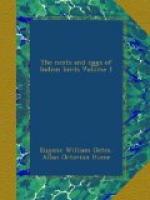“Well, would you believe it? on the 26th July, when every other Crow’s nest in Madras had hard-set eggs, or newly-hatched young ones, these two indefatigable birds set methodically to work to construct a nest on the south pillar—the one where all their earlier efforts were made last year, but not the one on which they succeeded in fixing their nest. They worked all the 26th and 27th, putting up sticks as fast as they fell down, and then desisted till the 4th August, when they began operations on the opposite (north) pillar with redoubled energy. Meeting with no better success they left off operations after a couple of days’ fruitless labour. Yesterday (after a delay of five weeks) they set to work on the south pillar again and succeeded in raising a great pile, which, however, was ignominiously blown down in the afternoon. To-day they are continuing their work indefatigably.”
Mr. J.E. Cripps has the following note in his list of birds of Furreedpore, Eastern Bengal:—“Very common, and a permanent resident, affecting the haunts of man. They build and lay in May. The Koel lays its eggs in this bird’s nest. In April, 1876, I saw two nests in the compound of the house in which I lived at Howrah, which were made entirely of galvanized wire, the thickest piece of which was as thick as a slate pencil. How the birds managed to bend these thick pieces of wire was a marvel to us; not a stick was incorporated with the wires, and the lining of the nest (which was of the ordinary size) was jute and a few feathers. The railway goods-yard, which was alongside the house, supplied the wire, of which there was ever so much lying about there.”
Typically the eggs may, I think, be said to be rather broad ovals, a good deal pointed towards the small end; but really the eggs vary so much in shape that, even with nearly two hundred before me, it is difficult to decide what is really the most typical form. Pyriform, elongated, and globular varieties are common; long Cormorant-shaped eggs and perfect ovals are not uncommon. As regards the colour of the ground, and colour, character, and extent of marking, all that I have above said of the Raven’s eggs applies to those of this species, but varieties occur amongst those of the latter which I have not observed in those of the former. In some the ground is a very pale pure bluish green, in others it is dingier and greener. All are blotched, speckled, and streaked more or less with somewhat pale sepia markings; but in some the spots and specks are a darker brown and, as a rule, well defined, and there is very little streaking, while in others the brown is pale and muddy, the markings ill-defined, and nearly the whole surface of the egg is freckled over with smudgy streaks. Sometimes the markings are most numerous at the large end, sometimes at the small; no two eggs are exactly alike, and yet they have so strong a family resemblance that there is no possibility of mistaking them. Generally




